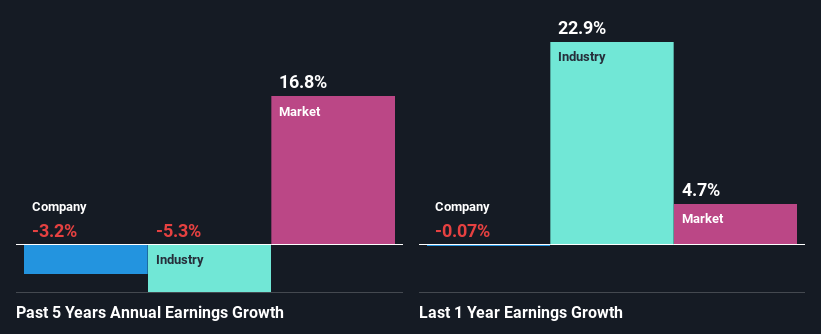- South Africa
- /
- Food
- /
- JSE:TBS
Tiger Brands Limited's (JSE:TBS) Stock Is Rallying But Financials Look Ambiguous: Will The Momentum Continue?

Most readers would already be aware that Tiger Brands' (JSE:TBS) stock increased significantly by 13% over the past three months. However, we decided to pay attention to the company's fundamentals which don't appear to give a clear sign about the company's financial health. In this article, we decided to focus on Tiger Brands' ROE.
Return on equity or ROE is an important factor to be considered by a shareholder because it tells them how effectively their capital is being reinvested. In short, ROE shows the profit each dollar generates with respect to its shareholder investments.
View our latest analysis for Tiger Brands
How To Calculate Return On Equity?
The formula for ROE is:
Return on Equity = Net Profit (from continuing operations) ÷ Shareholders' Equity
So, based on the above formula, the ROE for Tiger Brands is:
16% = R2.9b ÷ R17b (Based on the trailing twelve months to March 2024).
The 'return' refers to a company's earnings over the last year. That means that for every ZAR1 worth of shareholders' equity, the company generated ZAR0.16 in profit.
What Is The Relationship Between ROE And Earnings Growth?
Thus far, we have learned that ROE measures how efficiently a company is generating its profits. Based on how much of its profits the company chooses to reinvest or "retain", we are then able to evaluate a company's future ability to generate profits. Assuming all else is equal, companies that have both a higher return on equity and higher profit retention are usually the ones that have a higher growth rate when compared to companies that don't have the same features.
Tiger Brands' Earnings Growth And 16% ROE
When you first look at it, Tiger Brands' ROE doesn't look that attractive. Although a closer study shows that the company's ROE is higher than the industry average of 9.1% which we definitely can't overlook. But then again, seeing that Tiger Brands' net income shrunk at a rate of 3.2% in the past five years, makes us think again. Remember, the company's ROE is a bit low to begin with, just that it is higher than the industry average. So that could be one of the factors that are causing earnings growth to shrink.
As a next step, we compared Tiger Brands' performance with the industry and discovered the industry has shrunk at a rate of 5.3% in the same period meaning that the company has been shrinking its earnings at a rate lower than the industry. This does appease the negative sentiment around the company to a certain extent.

The basis for attaching value to a company is, to a great extent, tied to its earnings growth. The investor should try to establish if the expected growth or decline in earnings, whichever the case may be, is priced in. This then helps them determine if the stock is placed for a bright or bleak future. If you're wondering about Tiger Brands''s valuation, check out this gauge of its price-to-earnings ratio, as compared to its industry.
Is Tiger Brands Efficiently Re-investing Its Profits?
With a high three-year median payout ratio of 57% (implying that 43% of the profits are retained), most of Tiger Brands' profits are being paid to shareholders, which explains the company's shrinking earnings. With only very little left to reinvest into the business, growth in earnings is far from likely.
In addition, Tiger Brands has been paying dividends over a period of at least ten years suggesting that keeping up dividend payments is way more important to the management even if it comes at the cost of business growth. Based on the latest analysts' estimates, we found that the company's future payout ratio over the next three years is expected to hold steady at 58%. As a result, Tiger Brands' ROE is not expected to change by much either, which we inferred from the analyst estimate of 16% for future ROE.
Summary
Overall, we have mixed feelings about Tiger Brands. On the one hand, the company does have a decent rate of return, however, its earnings growth number is quite disappointing and as discussed earlier, the low retained earnings is hampering the growth. With that said, we studied the latest analyst forecasts and found that while the company has shrunk its earnings in the past, analysts expect its earnings to grow in the future. To know more about the company's future earnings growth forecasts take a look at this free report on analyst forecasts for the company to find out more.
Valuation is complex, but we're here to simplify it.
Discover if Tiger Brands might be undervalued or overvalued with our detailed analysis, featuring fair value estimates, potential risks, dividends, insider trades, and its financial condition.
Access Free AnalysisHave feedback on this article? Concerned about the content? Get in touch with us directly. Alternatively, email editorial-team (at) simplywallst.com.
This article by Simply Wall St is general in nature. We provide commentary based on historical data and analyst forecasts only using an unbiased methodology and our articles are not intended to be financial advice. It does not constitute a recommendation to buy or sell any stock, and does not take account of your objectives, or your financial situation. We aim to bring you long-term focused analysis driven by fundamental data. Note that our analysis may not factor in the latest price-sensitive company announcements or qualitative material. Simply Wall St has no position in any stocks mentioned.
About JSE:TBS
Tiger Brands
Engages in the manufacture and sale of fast-moving consumer goods in South Africa and internationally.
Excellent balance sheet average dividend payer.


